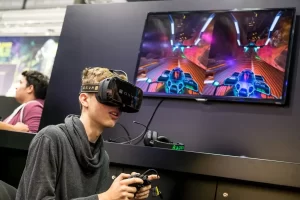
In recent years, virtual reality (VR) has exploded onto the gaming scene, promising players an immersive experience like never before. With VR headsets becoming more accessible and affordable, game developers are venturing into this exciting new frontier. However, developing games for virtual reality poses unique challenges that require innovative solutions. In this article, we will explore some of the key challenges faced by developers in this niche.
1. Hardware Limitations
One of the primary challenges in developing games for virtual reality lies in optimizing the software to work seamlessly with the available hardware. VR headsets have specific technical requirements in terms of processing power, display resolution, and tracking capabilities. Developers must carefully consider these limitations and adapt their games accordingly.
A major concern is achieving a consistent frame rate to prevent motion sickness among players. Virtual reality demands a higher frame rate than traditional games to provide a smooth and comfortable experience. Developers must utilize various techniques such as dynamic scaling, level of detail adjustments, and efficient rendering algorithms to maintain a stable frame rate on different VR hardware.
2. Motion Sickness
Motion sickness is a common issue experienced by VR users when in-game movements do not align with their physical movements, causing discomfort and nausea. Game developers need to consider player adaptability and provide options for customization to reduce the risk of motion sickness.
Implementing comfort settings within the game, such as adjustable field of view, control sensitivity, and movement speed, can help users find a configuration that suits their comfort levels. Additionally, providing clear warnings and instructions for new players about potential discomfort and allowing them to gradually acclimate to VR experiences can also mitigate motion sickness.
3. Immersion and Realism
Virtual reality aims to offer players a heightened sense of immersion and realism. Achieving this requires creating highly detailed environments, lifelike animations, and convincing physics simulations. However, these demanding requirements can strain even the most powerful hardware, resulting in trade-offs between visual fidelity and performance.
Game developers must strike a delicate balance between creating visually stunning worlds and ensuring smooth gameplay. This involves optimizing geometry, textures, lighting effects, and animations to maintain a high level of immersion while keeping performance requirements in check. Employing advanced techniques like dynamic level of detail rendering and occlusion culling can enhance realism without sacrificing performance.
4. User Interface
The virtual reality interface poses unique challenges due to the absence of physical buttons and tactile feedback. Developers must design intuitive and ergonomic user interfaces that consider the limitations of VR technology. Ensuring easy navigation, minimizing menu clutter, and utilizing intuitive hand gestures can provide a seamless and immersive user experience.
Implementing adaptive user interfaces that automatically adjust to the player’s virtual surroundings enhances the overall gameplay experience. These interfaces can dynamically change the size, format, and position of menus and icons based on the player’s position, movement, and field of view.
5. Performance Optimization
Virtual reality places significant demands on a system’s resources, and optimizing performance is crucial for a smooth and enjoyable gaming experience. To achieve this, developers employ various techniques such as culling invisible objects, optimizing shaders, and minimizing draw calls.
Continuous profiling, debugging, and performance testing ensure that the game runs smoothly across a range of VR hardware. Additionally, developers can employ adaptive quality settings that automatically adjust graphics settings based on the user’s system capabilities, ensuring optimal performance without compromising visual quality.
Conclusion
Developing games for virtual reality is an exhilarating yet challenging endeavor. From hardware limitations to motion sickness and achieving immersion, developers must overcome numerous hurdles to deliver a compelling virtual reality experience. By understanding and addressing these challenges head-on, developers can unlock the true potential of virtual reality and create groundbreaking experiences that captivate gamers around the world.


